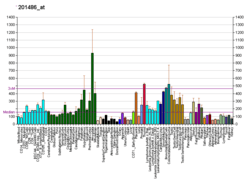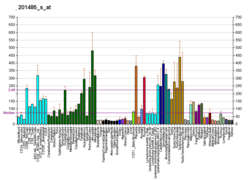Reticulocalbin 2
| RCN2 | |||||||||||||||||||||||||
|---|---|---|---|---|---|---|---|---|---|---|---|---|---|---|---|---|---|---|---|---|---|---|---|---|---|
| Identifiers | |||||||||||||||||||||||||
| Aliases | RCN2, E6BP, ERC-55, ERC55, TCBP49, reticulocalbin 2 | ||||||||||||||||||||||||
| External IDs | MGI: 1349765 HomoloGene: 2176 GeneCards: RCN2 | ||||||||||||||||||||||||
| |||||||||||||||||||||||||
| |||||||||||||||||||||||||
| |||||||||||||||||||||||||
| Orthologs | |||||||||||||||||||||||||
| Species | Human | Mouse | |||||||||||||||||||||||
| Entrez | |||||||||||||||||||||||||
| Ensembl | |||||||||||||||||||||||||
| UniProt | |||||||||||||||||||||||||
| RefSeq (mRNA) | |||||||||||||||||||||||||
| RefSeq (protein) | |||||||||||||||||||||||||
| Location (UCSC) | Chr 15: 76.93 – 76.95 Mb | Chr 9: 56.04 – 56.06 Mb | |||||||||||||||||||||||
| PubMed search | [3] | [4] | |||||||||||||||||||||||
| Wikidata | |||||||||||||||||||||||||
| |||||||||||||||||||||||||
Reticulocalbin-2 is a protein that in humans is encoded by the RCN2 gene.[5][6][7]
Reticulocalbin 2 is a calcium-binding protein located in the lumen of the ER. The protein contains six conserved regions with similarity to a high affinity Ca(+2)-binding motif, the EF-hand. The RCN2 gene maps to the same region as type 4 Bardet-Biedl syndrome (MIM:600374), suggesting a possible causative role for reticulocalbin 2 in the disorder.[7]
References
- 1 2 3 GRCh38: Ensembl release 89: ENSG00000117906 - Ensembl, May 2017
- 1 2 3 GRCm38: Ensembl release 89: ENSMUSG00000032320 - Ensembl, May 2017
- ↑ "Human PubMed Reference:".
- ↑ "Mouse PubMed Reference:".
- ↑ Wang JY, Zhen DK, Bianchi DW, Androphy EJ, Chen JJ (Apr 1998). "Assignment of the gene for ERC-55 (RCN2) to human chromosome band 15q22.33→q24.1 by in situ hybridization". Cytogenet Cell Genet. 79 (1–2): 60–1. doi:10.1159/000134683. PMID 9533013.
- ↑ Chen JJ, Reid CE, Band V, Androphy EJ (Aug 1995). "Interaction of papillomavirus E6 oncoproteins with a putative calcium-binding protein". Science. 269 (5223): 529–31. doi:10.1126/science.7624774. PMID 7624774.
- 1 2 "Entrez Gene: RCN2 reticulocalbin 2, EF-hand calcium binding domain".
Further reading
- Gerhard DS, Wagner L, Feingold EA, et al. (2004). "The status, quality, and expansion of the NIH full-length cDNA project: the Mammalian Gene Collection (MGC)". Genome Res. 14 (10B): 2121–7. doi:10.1101/gr.2596504. PMC 528928. PMID 15489334.
- Bouwmeester T, Bauch A, Ruffner H, et al. (2004). "A physical and functional map of the human TNF-alpha/NF-kappa B signal transduction pathway". Nat. Cell Biol. 6 (2): 97–105. doi:10.1038/ncb1086. PMID 14743216.
- Strausberg RL, Feingold EA, Grouse LH, et al. (2003). "Generation and initial analysis of more than 15,000 full-length human and mouse cDNA sequences". Proc. Natl. Acad. Sci. U.S.A. 99 (26): 16899–903. doi:10.1073/pnas.242603899. PMC 139241. PMID 12477932.
- Kirkpatrick LL, Matzuk MM, Dodds DC, Perin MS (2000). "Biochemical interactions of the neuronal pentraxins. Neuronal pentraxin (NP) receptor binds to taipoxin and taipoxin-associated calcium-binding protein 49 via NP1 and NP2". J. Biol. Chem. 275 (23): 17786–92. doi:10.1074/jbc.M002254200. PMID 10748068.
- Dodds DC, Omeis IA, Cushman SJ, et al. (1997). "Neuronal pentraxin receptor, a novel putative integral membrane pentraxin that interacts with neuronal pentraxin 1 and 2 and taipoxin-associated calcium-binding protein 49". J. Biol. Chem. 272 (34): 21488–94. doi:10.1074/jbc.272.34.21488. PMID 9261167.
- Weis K, Griffiths G, Lamond AI (1994). "The endoplasmic reticulum calcium-binding protein of 55 kDa is a novel EF-hand protein retained in the endoplasmic reticulum by a carboxyl-terminal His-Asp-Glu-Leu motif". J. Biol. Chem. 269 (29): 19142–50. PMID 8034671.
This article is issued from
Wikipedia.
The text is licensed under Creative Commons - Attribution - Sharealike.
Additional terms may apply for the media files.





